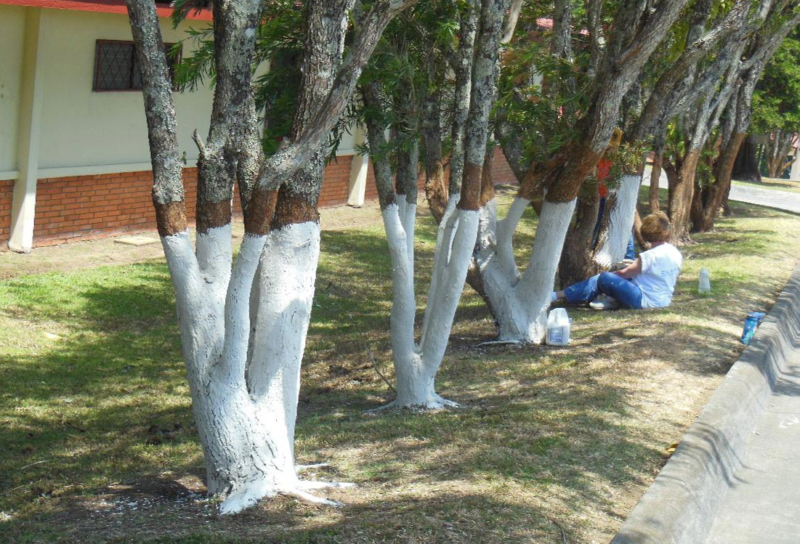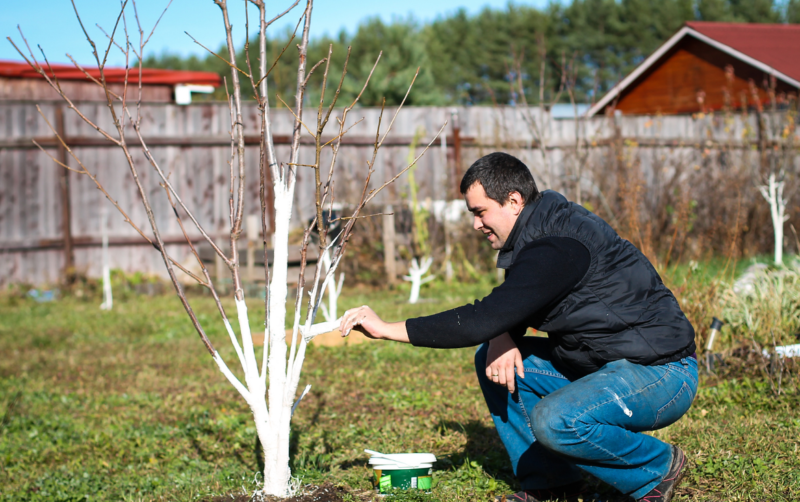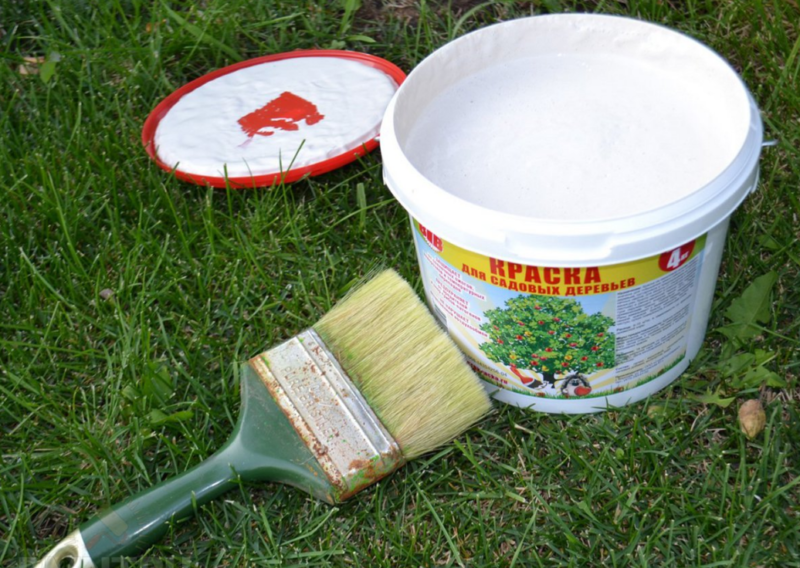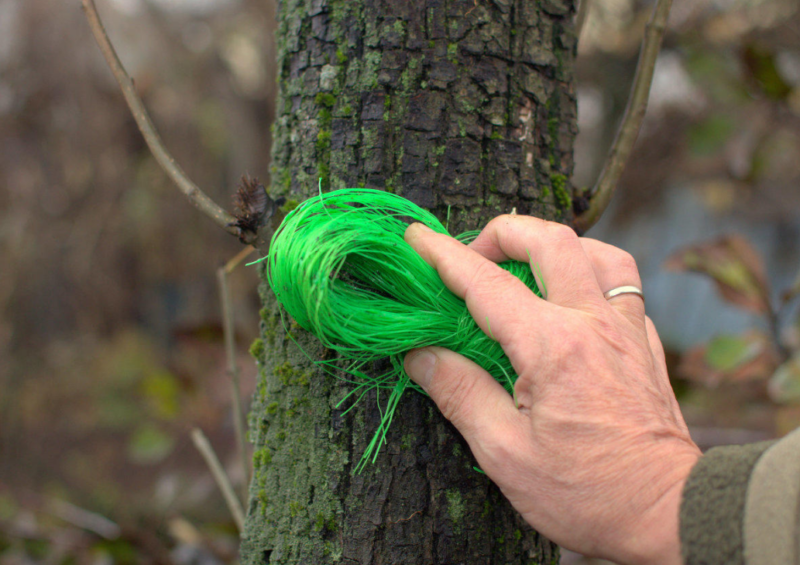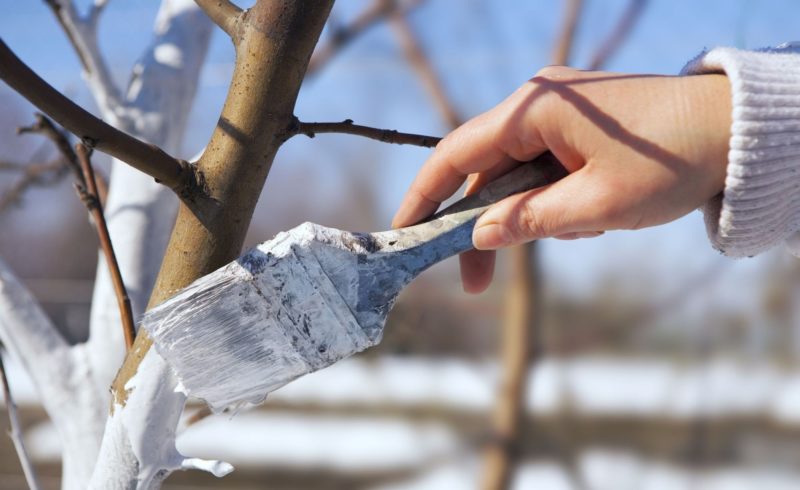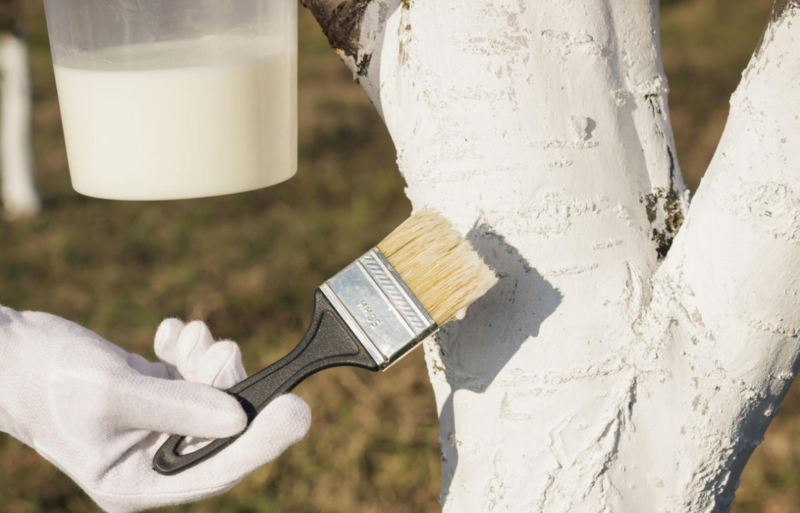Whitewashing of trees in the spring has become a tradition. After subbotniks, the inhabitants of the houses take out buckets of lime and begin to process her trunks. In the publication we will talk about why we need whitewashing trunks (and whether it is necessary at all), how to do it correctly, in what time frames and with what composition.
Material Content:
- 1 Why do you need whitewashing trees
- 2 The goals and features of this method of protection against pests
- 3 Spring whitewash deadlines
- 4 The composition of the solution for different types of trees
- 5 Preparation of trunks for the procedure
- 6 Applying Technique
- 7 Popular recipes
- 8 Gardener tips
- 9 What is harmful whitewashing of trees
Why do you need whitewashing trees
Hardworking people paint not only trees, but also all the columns that came into view, but all because many people consider this work to be purely decorative. This is far from the case, and the whitewashing of trees with lime is an important nuance, due to which the plantings remain healthy. But before talking about the need for whitewashing, it is worth a little talk about the bark of a tree.
The bark is the skin of a plant, which performs many protective functions:
- protects from frost;
- protects from heat, direct sunlight;
- closes the tree from the wind;
- protects the trunk from the teeth of rodents;
- prevents the tree from getting sick when infections get;
- the bark does not suffer so much at the hands of lovers to leave messages about their immeasurable love (carving with a knife the name of a half and so on) than the trunk itself.
The bark during the life of a tree, like the skin of a person, coarsens, becomes wrinkled and crack. All this is facilitated by weather conditions and past illnesses. A person protects his skin with creams, cosmetics, and trees also need such protection, and lime acts as a cream.
Some gardeners are sure that only adult specimens need whitewashing. There is an opinion that the bark of a young tree can be burned with a solution.This is true, but if the concentration is observed, the risk is negligible compared to what various pests can do with the bark! Therefore, it is necessary to whiten both adult trees and very young trees, bushes.
The goals and features of this method of protection against pests
The main goal of the whitewash events is the protection of landings. Therefore, it is not necessary to leave this process unattended, to abandon it.
The goals for treating slaked trunks are:
- Protection against an overheat in summer. The sun does not affect white color as much as darker.
- Protection against fungi, hypothermia in winter, early spring and autumn. How it works? Everything is simple. In the daytime, the sun's rays warm the trunk, especially the snow that reflects the rays. At night, the sun hides, and the air temperature drops sharply, which leads to cracking of the bark. Fungi get into the microcracks, harmful insects penetrate. A layer of lime, applied to the stake, closes these cracks, thereby protecting the whole tree.
- The solution is able to disinfect bark, destroy fungi and other organisms harmful to the health of the tree.
- Rodents do not like lime, it scares them away with its smell. It is especially important to protect fruit trees from the teeth of mice, moles and hares: they are more delicious than ordinary ones. For the most part, pests like to feast on young seedlings, which is why they need to be protected in the first place.
So, attributing the whitewashing of trees to decorative works is erroneous. Experienced gardeners know how important it is to host this event.
Spring whitewash deadlines
The main whitewash of fruit trees is in the spring, but knowledgeable gardeners recommend repeating the event three times a year.
Terms for work are as follows:
- The first whitewashing is done in early spring, from late February to mid-March. This is important, because the first thaws begin, and at night the thermometer column again goes far below the zero mark. Cracking occurs quickly, and with another thaw, pathogens and insect larvae penetrate the cracks.
- Re-work is necessary in the middle of summer to protect the tree from overheating.
- The third whitewash is autumn, renewing, which will protect the bark from severe frosts and winds. Work is being carried out from October to November.
In early spring, whitewashing is important for the plant to wake up later. White color will not allow the trunk to warm up under the warm March sun to a temperature optimal for sap flow. As a result, frost will not be scary at night, and late frosts will also cause a minimum of harm.
In spring, do not wait for the traditional May subbotnik, which is also called "Lenin", as it will be too late to carry out the work: the whitewashing will really become purely decorative.
The composition of the solution for different types of trees
You can whitewash trees with lime and water-based paint. The second option is most suitable for young trees with a tender, not yet cracked bark. The paint will lie in a thick layer, reliably fill all the cracks, and not a single bacterium or insect will get into them! But this option is considered expensive, so you are unlikely to want to use it for whitewashing street trees.
Water emulsion is applicable mainly for young fruit trees.
It is very difficult to apply paint to the cracked bark, as the consistency is dense - deep cracks simply will not fill.
As for the composition of the solution for whitewashing, it is universal for any type of tree.
The following products may be constituents of lime:
- Chalk can be an alternative substitute for lime. With the help of chalk, it is recommended to whiten young shrubs and trees, because it acts on the bark sparingly, since it is softer in composition than slaked lime. But still this product is not the most reliable defender, because it is washed off by precipitation after application much faster than other substrates.
- Clay is used as a viscous additive to the stock solution.It can be added to the chalk, and the mixture will last on the barrel longer. Therefore, clay is applicable for whitewashing young plantings. But for old trees with cracked bark, clay will be a salvation, because thanks to it, the solution becomes more viscous and, like putty, fills deep gaps into which insects and fungi can no longer penetrate.
- Fungicide - prevention of fungal diseases. Be sure to add the component to the stock solution if the trees have already been susceptible to fungus. According to the recommendations of gardeners, it is better to add copper sulfate as a fungicide. It is cheap, it disinfects the plant well and protects it from infection. Alternatives are iron sulfate, Bordeaux fluid.
- Glue. This component is added so that the whitewash is less susceptible to washing off by precipitation, as well as to increase its service life. For these purposes, use PVA glue, carpentry, casein or wallpaper. The first option is the cheapest, but also less preferred, because in comparison with other species it prevents the plant from breathing normally.
- Soap. It is better to use household. This is an alternative to replacing glue, soap also makes the mixture more viscous, lime sticks better to the barrel. This product is endowed with more sparing properties than glue, does no harm. But whitewashing lasts not so long.
- Manure. It is used to make the fluid more viscous, so it is better to stick to the trunk. But this is not the only advantage of the product. Manure acts as an antiseptic, disinfects the bark. Moreover, being absorbed into the plant tissue, it becomes a good top dressing.
- Carbolic acid. If rodents (mice, moles, rats, hares) began to appear actively on your site, and they liked fruit trees, then be sure to whitewash by adding carbolic acid to the solution. Rodents, therefore, do not like lime and chalk, but the acid will give the trunk an even more unacceptable smell for them, so the pests and a meter will not fit the plantings.
- Whey or whole milk. Excellent supplement not only for the viscosity of the solution, but also to protect the plant from fungal diseases, because dairy products suppress pathogenic organisms. In addition, milk or whey penetrate into the bark tissue, nourish with useful substances.
The composition of the solution is selected according to individual needs. All the prescribed ingredients are safe for plants, so do not worry about the health of your plantings. In the further contents you will find the most popular recipes for lime mixtures, which have proved themselves to be the best among hundreds of gardeners.
Preparation of trunks for the procedure
It is not recommended to apply the solution to unprepared bark, because then there will be little sense.
Follow the advice of experienced gardeners:
- The bark of the trunk and branches that you will whiten should be cleaned of moss, lichen, scales of the bark. Along with this, you will remove the wintering pests, the fungus to all, therefore, after cleansing, burn everything. Do not use scrapers, brushes and sponges, they can harm the bark. Just put on gauntlets of dense material, arm yourself to clean the cracks with a wooden flat stick. It is necessary to carry out work on a cloudy and humid day so as not to inhale fungal spores and dust. However, you can wear a respirator, but still in dry weather it is not recommended to do cleaning, because the spores will fly into branches and other plants.
- Next, you need to choose dry and warm weather to disinfect the trunk. Prepare an aqueous solution of ash and soap, process the trunk and branches.
- Trim old, dry, broken, diseased or frostbitten branches. Treat with a solution of ash, garden varieties or a clay mash.
- Treat the tree’s wounds with a clay chatter or special paste (“RunNet” and the like will do).
After preparing the trunk, wait for good and dry weather, begin to whiten.
Applying Technique
To whitewash the trees, prepare a respirator, gloves, goggles. Do not give up on the latter, because lime that has got on the mucous membrane of the eye can greatly harm (up to loss of vision). The solution on the bark can be applied with a brush, roller, but it is most convenient to use a spray gun or spray. Firstly, you will have to make less effort. Secondly, with the help of pressure you can pack even the smallest and deepest cracks. But the consumption of material when applied with a spray gun or spray increases many times!
It’s not worthwhile with the thoughts “protect, so protect” to start painting the entire trunk and each branch individually! Although it will be better for a tree, the gardener will hit hard on his pocket. Imagine how much material you need to whitewash the whole tree! It is enough to color the trunk from the ground (going deeper by 4 cm down, because it is in the root zone that harmful larvae live) 1.5-1.7 m up. Of the branches, only the lower ones should be whitened.
Apply one coat of solution, let it dry for 1 hour. Then apply another coat.
Popular recipes
You can use only a solution of lime or a water-based paint for whitewashing. But, on the advice of gardeners, it is worth creating a more multi-component composition, which will last longer on the bark, and will protect it from diseases and pests. We offer to consider popular compositions. Observe the recommended proportions, because overdoing it, you can burn the bark (especially for young plantings), causing more harm than pests and diseases combined.
Protects lime and copper sulfate from various diseases:
- Mix in 10 l of water 0.5 kg of copper sulfate and 2.5 kg of lime.
- In order to keep the composition better on the bark, add 0.2 kg of glue (PVA, carpentry, wallpaper).
- Let the solution brew for 15 minutes, get to work.
Protective-nourishing solution:
- For 10 liters of water, take 2.5 kg of lime, 2 full shovels of manure and 0.3 kg of copper sulphate.
- Mix. After 30 minutes you can whiten.
Solution for the youngest plantings with "paper" bark:
- It is necessary to crush 2.5 kg of ordinary chalk, dissolve it in 10 liters of water.
- Add regular paste from flour, 10 tbsp will be enough. l You can replace the paste with clay.
Protect from diseases, pests and rodents planting can be as follows:
- In 10 l of water, add 2 kg of lime (chalk can be used for young animals), 0.4 kg of copper sulphate and 10 tbsp. l carbolic acid.
- Stir, apply to trees.
The main thing is to observe the proportions of water and lime. The remaining components are not harmful. Rub soap, mix in solution, use milk and whey in general without fear.
Add fungicides in the dosages recommended by the instructions on the packaging.
Gardener tips
Whitewashing is necessary only in dry, calm weather.
If there is precipitation, then the solution from the trunks will be washed off before it has absorbed and dried. The wind picks up drops of lime, and they "decorate" your clothes with a lot of specks!
Also, gardeners recommend necessarily, at least once a year, to whiten young trees. In order not to harm the bark, make a solution in which lime will be 2/3 of the norm for 10 liters of water.
On a note! Whitening is necessary at least once a year, but it is better three times, as described above, in the spring, autumn and in the middle of summer. Whitewashing can be done at any time, even the rays of the sun will not harm the wet bark.
Copper sulfate can be added to the solution for whitewashing only once a year, and preferably after a year. The fact is that copper has the ability to accumulate and over time will begin to poison the plant.
What is harmful whitewashing of trees
Some believe that whitewashing trees can be harmful. For example, it is believed that the solution clogs the pores in the cortex, and it does not receive enough oxygen. This is possible, but only if glue is added to the mixture. To protect the tree, use as a thickener other ingredients that we wrote about above.
The fact that you can burn bark with lime, we have already said.In order to avoid this, observe the recommended proportions of the solution components, and add less substances for young plantings.
Whitewashing can do no harm more than anything, it only benefits!
By whitewashing the trees, you will sleep peacefully on frosty nights, knowing that your favorite plantings are protected. Moreover, the trunks will not be attacked by rodents and pests in the form of insects, they are not as afraid of fungal diseases as plants that have not been treated. Good luck


